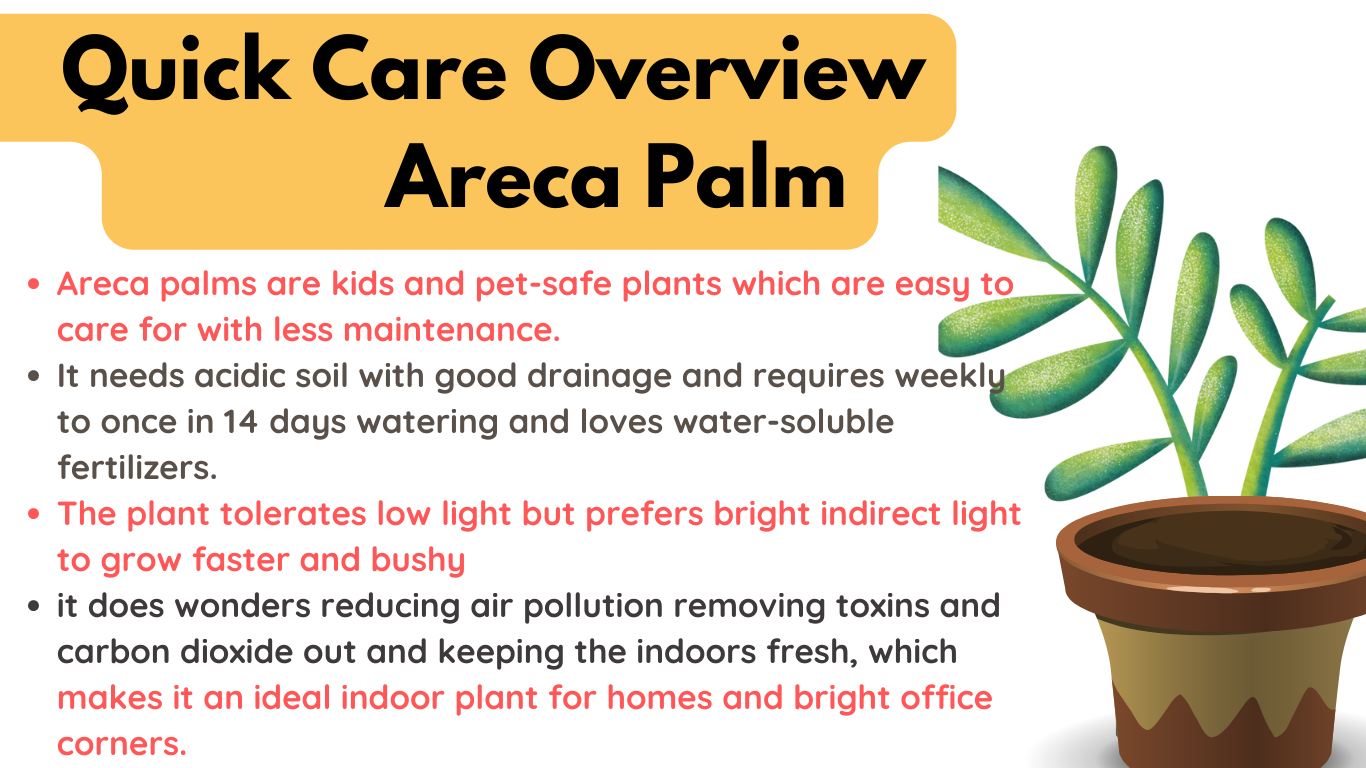Areca palms are kids and pet-safe plants which are easy to care for with less maintenance. It needs acidic soil with good drainage for indoor pots and requires weekly to once every 14 days watering and loves water-soluble fertilizers.
The plant tolerates low light but prefers bright indirect light to grow faster and bushy. Moreover, it’s resistant to a majority of pests and infestation making it easy to grow with less pesticide usage.
Though it’s an easy plant it does wonders reducing air pollution removing toxins and carbon dioxide out and keeping the indoors fresh, which makes it an ideal indoor plant for homes and bright office corners.

If you do like growing beautiful houseplants in your indoor garden then, the areca palm is the best one to pick. Despite being a tropical plant, areca palm can easily cultivate indoors in a suitable planter with proper care and attention.
This plant gives a magnificent view while put inside your house. All you need to do is just follow some basic planting rules and a caring routine to give your areca palm a good thrive. Here are some must-known facts in this regard, let’s check them quickly and steal a natural tropical look for your place easily-
Benefits of Having Areca Palm in Home:
Before you, though that areca palm only beautifies your house, let us tell you that this plant can benefit you either in plenty of ways. Some of the typical advantages you can get from bringing an areca palm plant house, are-
- Areca palm works as an excellent air-purifier by absorbing all the toxic air from a room
- As areca palm is a humid plant, it can escalate the humidity level of your indoor area perfectly
- Hence, it works for several health issues like breathing problems, itchy eyes, skin irritation, etc. which raise for dry air or low-humidity
- Like other green plants, the areca palm can help you to fight the signs of stress and anxiety
- Areca palm can absorb carbon dioxide from surroundings while releasing more oxygen to your house
- It doesn’t have any harmful or toxic parts and is thus, totally safe for your kids and pets
- According to the Feng-Shui, the areca palm plant brings luck and fortune to your house along with wealth and peace
- Besides eliminating pollutant air, it helps to solve breathing issues too by producing more oxygen
- And it is one of the most easy-to-handle indoor plants with an exotic look. So, if you want to renew your indoor interior with some beneficial houseplants, areca palm would be the best choice for you.
Areca palm is one of the cool low light tolerant indoor plants with less maintenance.

Areca Palm Plant Care: Quick Overview
Soil: Areca palm likes loose, porous, and well-drain type soil mixed with all-purpose potting soil. Make sure your planting soil has a good drainage system before placing the areca palm plant into it.
Water: This palm species doesn’t want much water, twice a month is enough even during its growing session.
Fertilizer: Use any water-soluble fertilizer mixed with peat moss or leaf mold to feed your areca palm properly.
Climate: Provide your indoor areca palm plant with bright but indirect sunlight. Thus, you can put it near the west or south-facing window and allow the sunlight through the window glass for the best result.
Pruning: Prune your bushy plant when some of the leaves turn yellow or brown or any discolored fronds that seem unusual to the whole plant.
Repotting: The plant turns extremely bushy within a couple of years; thus, you need to repot your plant once every two or three years.
You may also be interested in similar indoor plant care tips if so check out how to save an overwatered peace lily.

How to Care, Areca Palm:
Now, look into the growing details elaborately to sow and handle the growth of a healthy areca palm plant like an expert gardener-
Soil and Potting Mix:
If you are bringing planting soil from a nursery or gardening shop, then, pick well-drained soil that is mildly acidic. To prepare potting soil at home, with any organic material to make the soil slightly acidic and use loose sandy soil.
Maintain a pH level between 6.1 to 6.5 and make sure that the potting soil is loose around the root of your plant before completing the planation.
You can also make use of kitchen wastes to make plant food at home.
Light and Temperature:
Too much light can burn the leaves while less sunlight can hamper the air circulation system of areca palm badly. So, try to put your plant in a place where it can get bright but indirect sunlight.
Thus, you can put your potted areca palm plant on the west or south-facing window to provide it bright indirect light consistently throughout the day. Maintain the temperature between 60 to 75 degrees F constantly during the whole growing session.
How often to water:
Areca palm plant doesn’t need much water to thrive. Water your plant thoroughly once you sow them into the potting soil. Then, wait till the top surface of planting soil turns dry before watering your plant again. Make sure that the root area of the planting soil stays moist but not water-logged.
Try watering your plant after every 14 days and use a sprayer to make the leaves wet frequently after every few whiles.
How to Fertilize:
This species of palm plant is quite a heavy feeder and thus, you need to apply a good fertilizer to feed an indoor areca palm. Buy granulated liquid palm fertilizer and apply it in an 8-2-12 NPK ratio.
Make sure your chosen fertilizer is water-soluble and slow-release to get better results.
Areca Palm Pests and Diseases
Sometimes your indoor areca palm plant can get some troubleshoot issues despite getting enough care. Pets, diseases, nutrient deficiency, getting blots, etc. are some common issues you may face with this houseplant.
Try using some home remedies instead of chemical-based pesticides or plant medicines to get a side-effect-free outcome. Don’t forget to ensure the issue behind the troubleshoots of your favorite areca palm plant before applying remedies. Some effective remedies for curing pests and diseases of areca palm are-
- Neem oil
- Rubbing alcohol
- Baking-soda or vinegar made spray
- Hot peppers
- Copper sulfate
- High nutrient fertilizer
Besides applying these remedies, you must find out the reason behind the problems your indoor areca palm is getting.
How to Prune Areca Palm:
Wait for the time when your houseplant gets full growth, before starting pruning. Now, once you see that some leaves of your areca palm turn yellow or brownish, start your pruning session immediately. To prune the areca palm properly, flow these steps below-
- Take a pruning scissor and place it under running water to make it wet
- Now, take that wet pruner or scissor and prune only the infected part of your plant properly
- Make sure you only prune the discolored fronds and not the entire leaf
- Don’t damage any healthy frond or stem during this cutting session
- To make the course more secure and completely damage-free, try to propagate the areca palm plant only during the repotting
- During this time, you need to cut out the spotted or discolored clumps entirely with a wet scissor.
Do you plan to prune your nerve plant check out steps on how to prune indoor nerve plants and complete fittonia plant care?
How to Repot Areca Palm?
Once the plant turns busy and grows bigger, you must give your indoor areca palm plant a bigger space to thrive better. Once in a year or at least once after every two years, repotting would be necessary for a healthy areca palm houseplant. To do so, repotting is essential, but during this process, you need to take extra care, as repotting sometimes gets tricky for some tropical plants. So, here we come up with the right procedure of areca palm plant in a bigger planter-
- First of all, take out the whole plant along with its soil and make sure you don’t harm the root system during this process
- After this, lose the roots from congested soil, and, trim some unusually long root, if it is needed
- Prepare new potting soil by mixing cocoa peat, compost, and fresh planting soil equally
- Make sure your potting mix is fluffy and airy with good drained quality
- Now, bring a bigger size pot and pour half of the potting mix inside that pot, after securing the drainage hole properly
- Put the plant inside the planter now and then pour the remaining potting soil over the top of your plant base
- Pat the soil properly and dig slightly with a scrapper after completing the re-plantation
- Finally, water the plant thoroughly and keep it outside the house for at least 1 week to give your plant the best thrives.
Pinterest Image: How to Care for Areca Plam – Indoor Plants for Low Light

FAQ:
Is Areca Palm Good for Health?
Having an areca palm plant indoors is good for your health, especially for your respiratory system, as it is a good air-purifier and produces oxygen effectively, along with absorbing toxic air.